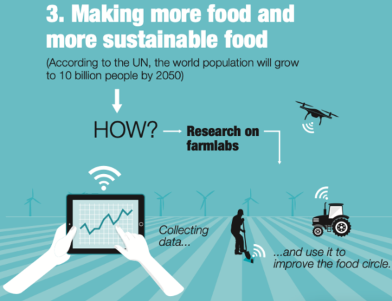By 2050 the world population is expected to grow to 10 billion people. This means a lot of mouths to feed, which inevitably demands much from our food production system. CIRCLES aims to boost food production while decreasing the environmental footprint of the process. This is a significant task to undertake given the enormous challenge lying ahead.
While there are already many initiatives today that contribute to sustainable food production, the aim of CIRCLES is to develop in-depth scientific knowledge about it. A fundamental aspect regarding a sustainable food supply is the management of soil. If we know how to extend and preserve the life of agricultural land in an ecological way, we can ensure a sustainable method of growing food. This is exactly what CIRCLES partners from the Natural Resources Institute Finland (LUKE) and Soilfood Oy studied. This blog article describes in brief the research and the implications of their findings in general, as well as for CIRCLES.

Carbon content of agricultural soils is currently declining on a global scale. Although this might not be directly recognised as a problem by the average citizen, it has some serious consequences. A decline in carbon in agricultural soils threatens soil fertility and makes soil prone to erosion. This is problematic for the cultivation of food, already today, but especially in the long term.
During a four-year field trial in Finland, LUKE and Soilfood Oy investigated how to decrease soil erodibility in a circular manner. For this, they used organic sludges that are produced as side streams by the pulp and paper industry. These occur in high quantities (in Finland, 420,000 Mg dry matter per year) and are usually incinerated with low net energy recovery. With the idea of integrating these valuable substances into new value chains, the researchers used different organic sludges and studied their effect on cereal yield, soil carbon content and fungal and bacterial composition. The trail included 1) composted sludge, 2) lime-stabilized sludge (both derived from the process water treatment plant at the factory) and 3) fiber sludge, which consists of cellulose fibers that are too short for the mill’s final product.
The field experiment and rainfall simulation study indicated that fiber, composted and lime-stabilised sludge from the pulp and paper industry can be used to mitigate adverse effects of food production on the quality of discharge waters. The amendments demonstrated a potential to reduce soil erosion through soil monoliths over several years. They also increased the pools of microbial-bound carbon and nitrogen in soil. A particularly interesting observation was the increased proportion of Sebacinales fungi, which in organic farming are used as indicators of improved soil quality. However, on cereal yield and grain quality, the soil amendments had only minor effects.
The finding that the use of pulp and paper mill sludges decreases soil erodibility is important for two reasons. Firstly, because it helps us better understand the composition of agricultural land and the effects of adding organic by-products to the soil. And secondly, because it is a step in the right direction for practical use of valuable organic side streams. This is essential for a circular economy, but also contributes to CIRCLES’ goal of delivering new and healthier food applications through microbiome research.
Article reference:
Rasa K, Pennanen T, Peltoniemi K, et al. Pulp and paper mill sludges decrease soil erodibility. J. Environ. Qual. 2021;50:172–184. https://doi.org/10.1002/jeq2.20170
Written by Hague Corporate Affairs
